Exploring a Hidden Gem in Guatemala
El Pilar is a unique, natural habitat located just 3.5 km from La Antigua’s central park
A little-known natural sanctuary is located just outside of La Antigua Guatemala where pools are brimming with fresh, mountain spring water every day and where multi-colored hummingbirds buzz around in sporadic sprints by the dozens.
“It’s the best-kept secret in Antigua because no one really knows about it,” Bonnie Baguley, a longer-term traveler, remarked.
Those in search of a quick escape to an alluring natural setting can find El Pilar by following the path that leads past the church of San Cristóbal El Bajo to its end. Don’t be deceived by first appearances. El Pilar is a farm that sustains itself through mining rock. When you enter the property, you’ll see scattered mounds of rock and hear the drone of heavy machinery churning over gravel. Venture a little farther up the gravel road and you’ll find three sky-blue pools of varying depths. For just Q10, you can take a refreshing dip in water that comes straight from the surrounding mountains—salt and chlorine free.
The true treasure, however, lies beyond the pools.
“I didn’t even know about the rainforest area behind [the pools]. The last time we went we were—well, I can’t even remember why we went up there. We were just like, what do you think is up there?” Baguley recalled.
What lies beyond is a project in the making. There are no signs indicating that the farm is gradually developing a tourist-friendly infrastructure in a remarkably well-preserved natural reserve of endemic forest and wildlife. Perhaps the only hint to suggest that uphill lies a sanctuary of virtually untouched biodiversity is the distant calls of more than 130 species of birds. A bounty of other wildlife can also be found on the farm property, including grey fox, snakes, bats, porcupines, skunks, opossums, raccoons, frogs and lizards. Coffee grows wildly and naturally. At the highest points of the mountainous terrain, fragile cloud forests still struggle to thrive.
The farm was bought two generations ago with the idea of using the 11 caballerías of land (roughly 1,200 acres) for the sustainable harvest of timber. But the original purchaser, Germán Rivera, was not aware that the region was listed as a Zona de Veda. In other words, it is a protected area and altering the natural landscape, particularly through the removal of any trees, is prohibited.
“Because of the type of mountain and because of its geographical position, as well as the type of forest that’s above, the place generates a lot of water. As you can see we have water all over the place and this water goes to the surrounding communities,” Juan Rivera said.
Juan Rivera is the grandson of Germán Rivera and is now the manager of the special reserve. With a degree in eco-tourism from the Universidad del Valle in Guatemala City, this haven holds a special interest for Juan Rivera. The young grandson is hoping to more fully realize the benefits of such a unique natural sanctuary by developing minimally intrusive infrastructure throughout the property to make it more accessible to like-minded nature enthusiasts.
“So, all this time the place remained as it was, without anybody knowing what to do, except my grandfather who built the pools,” explains Rivera. “That was the only thing we had here: the pools and the little houses you can still see. After that, we started with the rocks and gravel about 10 years ago. And when I used to work here, I started to notice that it is a very beautiful place. The ecological conditions here are very unique. So, for my part, I began to say that we have to protect this place and that’s the way it started,” Rivera said.
Approaching the natural reserve, you must cross a wooden footbridge that runs along small, trickling ponds ornamented with bright, tropical flowers. These man-made ponds are used for growing a conservative quantity of tilapia. Next is a winding cobbled path that weaves between more neon-colored blossoms and sun-highlighted palms before emptying into a garden specially designed for hummingbirds. The row of artificial feeders and the specialized garden draw a constant hoard of varying species — one of which is the native rufous sabrewing.
“Mainly what you can see here are species of birds endemic to Southern Mexico and Northern Central America. And you can see here, drinking from the feeders, is one of the endemic hummingbirds. It is the one that is like cinnamon—big with a brown back. It’s a very unique specie to observe,” according to Rivera.
Visitors can spend hours watching the rufous sabrewing, the violet sabrewing, the green-throated mountain gem and many others from the large, wooden observation deck—a good place to rest before continuing along a wooden and natural rock path that plunges farther into pristine forest and jungle. About two kilometers of semi-strenuous hiking will leave even the fittest huffing and puffing as the trail winds up a wild mountain face. Guide Moisés Batres Morales estimates that the path challenges visitors with nearly 200 ascending steps before reaching the end of the trail. And still, those curious enough can continue the hike. Follow the gravel road past more forest until it eventually opens up into various clearings that are occasionally dotted with small shacks, cottages and cabins. Visitors can spy remnants of a colonial farm, as well as a set of palm trees that are reportedly more than 100-years old.
Both indigenous locals and nature-loving foreigners alike can be found calling these high-altitude clearings home. Anyone who does venture up this far is rewarded with breathtaking vistas of the Agua, Fuego and Acatenango volcanoes as well as much of the Panchoy Valley—including La Antigua, San Pedro Las Huertas, Chimaltenango, Cuidad Vieja, San Mateo and Cerro de la Cruz. It is at these altitudes that visitors can begin observing the unique climate, flora and fauna of the property’s delicate regions of cloud forest.
El Pilar is located about 3.5 kilometers from the central park. Begin by walking south toward 7a calle until you reach San Francisco Church. Walk past the church and behind it to find the path leading to Santa Ana. Look for El Calvario Church and INVAL, the institute for men. When you reach the landmarks, cross to the left to find the end of a path. You will be able to see the Church of San Cristobal El Bajo. Walk up the path, past the church until you reach El Pilar. The walk is about 20 minutes. A ride in a tuk tuk or taxi will take less than 10 minutes.
- Platform paths wind through El Pilar so visitors can observe without impacting the area (Thor Janson)
- The view from El Pilar makes it possible to take photos like this spectacular shot by Thor Janson
- Remnants of a colonial farm in the clearing with a pair of 100-year-old palm trees (Laura Mcnamara)
- You can take a refreshing dip in spring water—salt and chlorine free. (photo Laura Mcnamara)
- Visitors can spend hours watching the rufous sabrewing, the violet sabrewing, the green-throated mountain gem and many other birds from the large, wooden observation deck (Thor Janson)
- A visitor to the El Pilar garden specially designed for hummingbirds (Thor Janson)
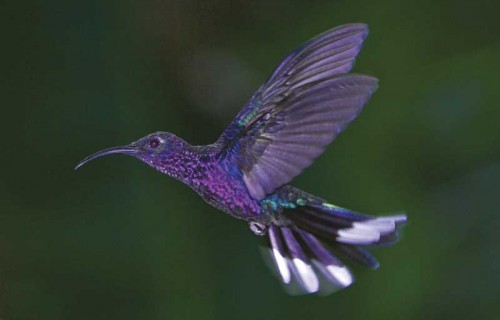
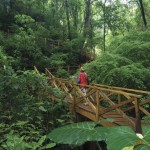
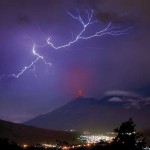
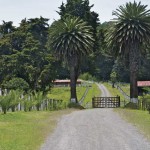
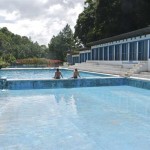
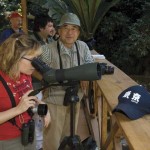
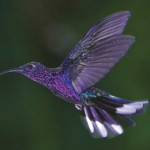
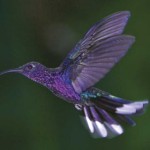
A FEW YEARS AGO, I HAD THE OPPORTUNITY TO SEE THIS PLACE, THAT IS SUCH A BEAUTY AND I KNOW ALL THE EFFORT THAT THE RIVERA´S FAMILY PUT IN TO IT. IM REALLY PROUD TO HAVE A PLACE LIKE THIS IN GUATEMALA.
Thanks Mafer… and I suggest you go back and have another visit!!
Is the walk back and forth, as well as the trail itself, safe to do alone during the day? I know that, for example, one needs to be careful when climbing up to the cross in town. Thanks. I’m new to town.
Thanks for the info, i go every year with my wife to guate (she’s from guatemala) and next year i have a new place to see.
@James Right now, the walk is back and forth unless you want to take the gravel road back down. I would suggest walking back using the forest trail though. And it’s very safe to walk the grounds of El Pilar during the day.
@Saul I’m sure both you and your wife will love it!!
Editor’s note: El Pilar is currently charging Q40 for entrance into the natural reserve.
The fish ponds were not in current production but the birding is still spectacular. If you get to the top, the views are unparalleled to anywhere else in Antigua.